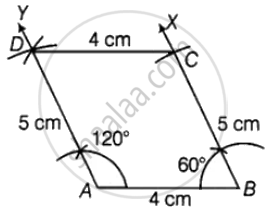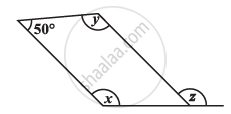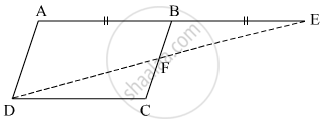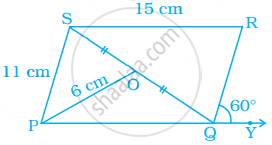Advertisements
Advertisements
Question
Construct a parallelogram ABCD in which AB = 4 cm, BC = 5 cm and ∠B = 60°.
Solution
As we know that the opposite sides of a parallelogram are equal.
So, AB = DC = 4 cm
BC = AD = 5 cm
∠B = 60°
∠A + ∠B = 180° ...[Sum of cointerior angles]
∠A = 180°
Steps of construction:
Step I: Draw AB = 4 cm.
Step II: Draw ray BX that is ∠ABX = 60°.
Step III: Mark a point C that is BC = 5 cm.
Step IV: Draw a ray AY that is ∠YAB = 120.
Step V: Mark a point D that is AD = 5 cm.
Step VI: Join C and D.
Hence, ABCD is required parallelogram.
APPEARS IN
RELATED QUESTIONS
Consider the given parallelogram. Find the values of the unknowns x, y, z.

The adjacent figure HOPE is a parallelogram. Find the angle measures x, y and z. State the properties you use to find them.

In the given figure, `square`ABCD is a parallelogram. Point E is on the ray AB such that BE = AB then prove that line ED bisects seg BC at point F.

Construct ☐ BARC such that l(BA) = l(BC) = 4.2 cm, l(AC) = 6.0 cm, l(AR) = l(CR) = 5.6 cm
The angle between the two altitudes of a parallelogram through the same vertex of an obtuse angle of the parallelogram is 30°. The measure of the obtuse angle is ______.
In the given figure, ABCD and BDCE are parallelograms with common base DC. If BC ⊥ BD, then ∠BEC = ______.

The adjacent sides of a parallelogram are 5 cm and 9 cm. Its perimeter is ______.
In parallelogram PQRS, O is the mid point of SQ. Find ∠S, ∠R, PQ, QR and diagonal PR.

A diagonal of a parallelogram bisects an angle. Will it also bisect the other angle? Give reason.
In parallelogram ABCD, the angle bisector of ∠A bisects BC. Will angle bisector of B also bisect AD? Give reason.
